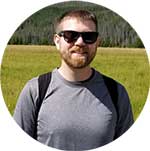I received an email from a tour guide, Jack, I had met in Copenhagen: “I’m touring Central America, would you like to join?” Though I’d only known the man for 12 hours as we toured the bars in the City of Spires, I immediately bought a plane ticket. My travel writing career had begun six months earlier and I desperately needed to source new content.
We agreed to meet in San Salvador, El Salvador, where I would then follow Jack across the border to Honduras. His route had us destined for Copan Ruinas, San Pedro Sula, and La Ceiba before parting ways after we reached the Caribbean island of Utila a week later. With an itinerary set, I wasted no time in contacting as many publishers as I could to pitch story ideas. Days before my departure, one magazine commissioned me for a story about the “Whale Shark Capital of the Caribbean.”
I now had my first official travel assignment—and I planned to turn this one trip into multiple articles. Here are five tips I used to maximize my trip and create new content.
1. Plan multiple story pieces.
The whale shark story was the primary story, but my secondary goal was to collect more article ideas along the way. I researched and planned story ideas for every stop of our trip, which included developing the ideas for specific outlets.
The publication buying my Utila story may also be interested in a San Salvador story. Other magazines focused on island life may also have an interest in Utila’s wonders. Before heading out to cover a story, try to identify as many relevant publications as possible where you can pitch these articles.
2. Chase new stories as they spawn.
One person we met while traveling was volunteering at a reptile sanctuary and invited us for a tour. While in the sanctuary, we were encouraged to visit the brand-new chocolate factory only two blocks away. Both destinations weren’t on the itinerary, yet both became separate articles—one was even accepted for publication a few days after I pitched it.
Follow the road which leads to your planned stories but don’t be afraid to take a few detours if you have the opportunity. There are stories hidden in every destination; sometimes a stranger’s suggestion and a spur of the moment excursion will help you uncover them.
3. Plan for problems.
Jack arrived in San Salvador a day late. Transportation issues caused us to lose almost a full day of travel. The whale sharks that I was supposed to do a feature on no-showed in the sea. Despite these unavoidable problems, I was prepared for them. I booked a daytrip around El Salvador regardless of whether Jack could join in time. I turned our long border crossing journey into a story of its own. With no whale shark sightings, I gave my publisher a unique piece highlighting Utila’s hidden gems.
Plans change, but my readiness to adapt and overcome helped me turn three problems into three stories. Stay committed to your assignment while acknowledging that you’ll need to get creative if suddenly your story has disappeared.
4. Prioritize photography.
My Nikon D3500 was attached to my hip nearly every moment of the trip and I loaded up my memory card with hundreds of photos. My photographs were both deliberate and seemingly random: I shot specific images before, during, and after my interviews according to the interview content. I also shot B-roll footage wherever I went, to build my portfolio of stock photos.
When travelling, you only have one opportunity to collect everything you need, especially photos. It’s important to take focused and unique shots relevant to your planned pieces, but I also recommend shooting other backup images to use for future pieces or to include in your portfolio.
5. Network in each destination.
The most progress you’ll make as a travel writer occurs during your travels. In every place we stayed, I talked to as many of the other residents as possible. I asked about their own travels, perspectives, and advice about destinations around the world. I tried to exchange contact info with those I spent the most time with, including my tour guides. By the time I flew home, I made a dozen new friends around the world who inspired me to visit them and chase the stories happening in their own backyards.
Some of these individuals actually became references and interview subjects for new stories I wrote and published months after we met. Broaden your network with other passionate travelers and you’ll realize that you’re constantly inspired and informed about new content.
Even the best laid plans go awry, but prior preparation and the ability to chase the stories you stumble upon can ensure that you’ll not arrive back home empty handed.


